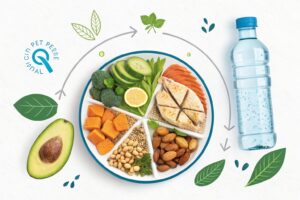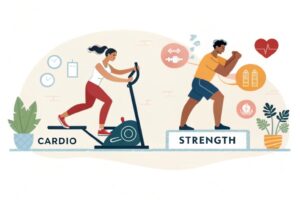The First 7 Days: A Beginner’s Weight Loss Plan– Embarking on a weight loss journey can feel overwhelming. With endless information online, knowing where to start is often the biggest hurdle. This is where a structured, supportive first week can make all the difference. The First 7 Days: A Beginner’s Weight Loss Plan is designed not for drastic results, but to build a powerful foundation of healthy habits. Forget deprivation and confusion; this guide focuses on sustainable changes, science-backed principles, and setting you up for long-term success. Let’s transform your anxiety into action and your goals into reality.
Setting Realistic Expectations: What Can You Achieve in 7 Days?
It’s crucial to begin with a healthy mindset. The scale might show a noticeable change in your first week, but much of this is often water weight, not pure fat loss. As your body depletes its glycogen stores (stored carbohydrates), each gram of glycogen releases 3-4 grams of water with it. This can lead to a rapid initial drop on the scale. However, this is not a sustainable rate of loss and should not be the sole measure of your success. The true achievement of The First 7 Days: A Beginner’s Weight Loss Plan is behavioral. Your goal is to consistently make better choices, understand your body’s signals, and establish a rhythm that feels manageable, not miserable.
For example, a realistic and healthy goal for this initial phase is not a specific number of pounds lost, but rather a list of non-scale victories. These can include: drinking 8 glasses of water each day, cooking three healthy meals at home, adding a 20-minute walk to your daily routine, or simply going to bed 30 minutes earlier to improve sleep. Celebrating these small wins builds confidence and reinforces the identity of someone who makes healthy choices, which is far more powerful for long-term adherence than any quick fix. Remember, you’re building a marathon runner’s mentality, not a sprinter’s.
Building Your Foundation: The Core Pillars of Nutrition

Hydration: Your Secret Weapon
Water is the most underrated tool in weight management. Proper hydration is essential for every metabolic process, including lipolysis (the breakdown of fat). A study published in the Journal of Clinical Endocrinology and Metabolism found that drinking 500ml of water increased metabolic rate by 30% for about an hour. Beyond metabolism, water helps you feel full, reducing the likelihood of mistaking thirst for hunger. Aim for at least 2-2.5 liters per day. Start your morning with a large glass of water and keep a bottle with you throughout the day. If plain water is unappealing, infuse it with lemon, cucumber, or berries for a flavor boost without added sugars.
Macronutrient Balance: Protein, Carbs, and Fats
Instead of cutting out entire food groups, focus on balance and quality. Prioritize lean protein (chicken breast, fish, tofu, lentils) at every meal. Protein promotes satiety, preserves lean muscle mass while you lose weight, and has a high thermic effect, meaning your body burns more calories digesting it. Choose complex carbohydrates like oatmeal, quinoa, sweet potatoes, and whole-grain bread over refined carbs (white bread, pasta, sugar). These provide sustained energy and are packed with fiber. Finally, include healthy fats from sources like avocados, nuts, seeds, and olive oil. Fat is not the enemy; it’s vital for hormone function and helps you absorb nutrients. A simple plate method: fill half your plate with non-starchy vegetables, a quarter with protein, and a quarter with complex carbs.
Your actionable 7-Day Kickstart Plan
This plan is a template—adjust portions based on your hunger levels and swap foods for similar nutritional options you enjoy.
Days 1-2: Focus on Hydration and Whole Foods. Start each day with a glass of water. Breakfast could be scrambled eggs with spinach and a slice of whole-wheat toast. Lunch might be a large salad with grilled chicken, lots of veggies, and a vinaigrette dressing. For dinner, try baked salmon with quinoa and steamed broccoli. Snack on Greek yogurt or an apple with a tablespoon of almond butter.
Days 3-4: Incorporate Mindful Eating and Movement. Continue with the hydration and whole foods focus. Now, practice eating without distractions. Chew slowly and savor your food. This allows your brain to register fullness, preventing overeating. Add 20-30 minutes of moderate activity, like brisk walking, cycling, or a beginner-friendly workout video. You don’t need a gym; consistency is key.
Days 5-7: Reflect, Adjust, and Solidify Habits. By now, you’ll notice what’s working and what’s challenging. Did you struggle with an afternoon energy slump? Maybe you need a more protein-rich lunch. Were you starving by dinner? Perhaps your snack wasn’t substantial enough. Use these days to fine-tune your approach, ensuring this plan can evolve into a long-term lifestyle.
Moving Your Body: Exercise for Beginners

In the first week, the goal of exercise is not to burn a massive number of calories but to build a habit and boost your mood. For complete beginners, too much too soon can lead to injury and burnout. Low-Impact Cardio, such as walking, swimming, or using an elliptical machine, is perfect. It elevates your heart rate, improves circulation, and builds endurance without stressing your joints. Aim for 20-30 minutes on most days.
Strength Training is equally important, even for weight loss. Muscle tissue is metabolically active, meaning it burns more calories at rest than fat tissue. You don’t need weights to start. Bodyweight exercises like squats, lunges, push-ups (on your knees if needed), and planks are incredibly effective. Try incorporating two days of these exercises into your week, focusing on form over repetitions. This combination of cardio and strength lays the groundwork for a faster metabolism and a stronger, more capable body.
Overcoming Common First-Week Challenges
Managing Hunger and Cravings
It’s normal to experience hunger as your body adjusts to a new eating pattern. The key is to distinguish between true hunger and emotional or habitual cravings. True hunger comes on gradually and can be satisfied with any food. A craving is often sudden and specific (e.g., chips or chocolate). To combat true hunger, ensure every meal contains protein and fiber. If a craving hits, drink a glass of water, wait 15 minutes, and then see if it persists. Often, we are simply dehydrated.
The Importance of Sleep and Stress Management
Two often-overlooked factors in weight loss are sleep and stress. Poor sleep (less than 7-8 hours) disrupts the hormones leptin and ghrelin, which regulate appetite. You end up feeling hungrier and less satisfied after eating. High stress increases cortisol, a hormone that can promote abdominal fat storage and trigger cravings for high-fat, high-sugar foods. Prioritize a regular sleep schedule and incorporate stress-reducing activities like meditation, deep breathing, or gentle yoga into your first week. This holistic approach addresses the root causes of weight gain, not just the symptoms.
Sustaining Momentum Beyond the First Week
Congratulations on completing The First 7 Days: A Beginner’s Weight Loss Plan! This week was about proof of concept—proving to yourself that you can make positive changes. Now, the journey continues. Reflect on what you learned. What meals did you enjoy? What time of day do you prefer to exercise? Use these insights to build a plan for week two. Maybe you want to try a new healthy recipe or increase your walking time by 5 minutes.
The ultimate goal is to make these habits automatic. Don’t be discouraged by a future slip-up; it’s a part of the process. The key is to return to your plan immediately. Consider tracking your meals and moods in a journal or using an app to identify patterns. Most importantly, be patient and kind to yourself. Sustainable weight loss is a gradual process of becoming the healthiest version of yourself.
Ready to continue your journey? Share your first-week successes and challenges in the comments below—let’s support each other! For your next step, explore our guide on “How to Build a Healthy Meal Plan” to keep your momentum going strong.



